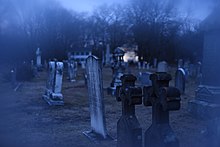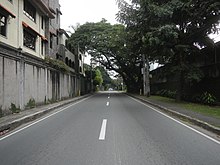White Lady
Common to many of these legends is an accidental or impending death, murder, or suicide and the theme of loss, betrayed by a husband or fiancé, and unrequited love.
In popular medieval legend, a White Lady is fabled to appear by day as well as by night in a house in which a family member is soon to die.
Called Dama Branca or Mulher de Branco in Portuguese, the Brazilian Lady in White is said to be the ghost of a young woman who died of childbirth or violent causes.
Luís da Câmara Cascudo's Dicionário do Folclore Brasileiro (Brazilian Folklore Dictionary) proposes that the ghost is related to the violent deaths of young white women who were murdered by their fathers or husbands in an "honor" killing.
Monteiro Lobato in his book Urupês describes a young woman starved to death by her husband because he suspected she was in love with a black slave and only gave her the stewed meat of his corpse for food.
Accordingly, the grieving woman is said to have chosen the site to end her life by throwing herself in the raging waters while wearing the wedding dress that she had recently ordered to be made.
According to the legend, a canon fell in love with her, so she hid in the castle disguised as a choir boy, but she was discovered when the Bishop of Ösel-Wiek visited Haapsalu and subsequently immured in the wall of the chapel for her crime.
[9] A variation of the tale holds that the white lady of the Plassenburg is the unfortunate widow Bertha of Rosenberg from Bohemia, overthrown by the heathen Perchta.
[11][12][13][14][15] The castle is the residence of the kings of Prussia, and the stories associate the lady with several historical figures, most notably Anna Sydow, the paramour of Joachim II of Brandenburg (father of John George), who bore him two extramarital children.
[17] Friedland in Brandenburg is claimed to be haunted by a white lady, supposedly the daughter of a baronet cursed by her father for not giving him an heir.
According to the story, the nobleman encased her in the cellar of his manor Haus Aussel to assure she could not betray him while he went away to war, but he never returned, and her spirit supposedly haunts the premises forever afterwards.
In Charles Fort (Ireland), there is the story of a white lady, the ghost of a young woman that died on her wedding night.
The White Lady is the name of a female ghost that lives in Verdala Palace in the small forest of Buskett, Rabat, Malta.
Legend has it that many years ago, the niece of Grand Master de Rohan, was engaged to be married to a suitor whom she did not love.
While she tells the children goodnight and bids them to return home, she advises the teenagers to "find another" or to join her and become a part of her "shadow" (her ghostly followers).
[31] This historical event has spawned a few variations on a White Lady ghost story based around the death of the woman who burned with the castle farm.
The most common versions of the tale involve the woman having two fighting lovers or of the site being burned on her wedding day by a jealous nobleman.
[31] Dutch symphonic black metal band Carach Angren also has a full concept album dedicated to this version of The White Lady.
In other instances, it is said that when solitary people drive on that street in the early morning, they briefly see the face of a white-clad woman in the rear-view mirror before she quickly disappears.
[36] One are from Balangiga Ladies dressed in White which were massacred together with the Male Population of it, along with an Old Church, sigthings reported at Pagsanghan, Samar too.
"The Maidens of Uley" is an East Siberian legend of the west Buryad people from the village of Ulei (or Ungin), Irkutsk Oblast, Russia.
It centers around a woman without a name, supposedly the first wife of the knight Humbert de Choulex, under whose leadership the castle was constructed in a swampy area at the beginning of the 14th century.
[41] In a version from 1870, which was published in 1902, a certain Jean Bahut told the story that he went out to the castle ruins on Christmas Eve as a sixteen-year-old during the French occupation of Geneva at the beginning of the 19th century to shoot some animals for dinner with his widowed and impoverished mother.
While the White Lady rewarded his commitment to his mother with a treasure of gold and silver, she punished his wealthy and greedy relative one year later in a deadly way by tricking and locking him into the vaults.
The neighbouring municipality of Choulex still bears the name of the family, whose lineage Humbert as the first lord of the castle was from and which was first mentioned in a document almost nine hundred years ago.
The collaboration by four Geneva-born and/or -based artists, included a video installation and was titled Qui a Peur de la Dame Blanche?
[45] Thirteen tales within England also suggest that the White Lady may be a victim of murder or suicide who died before she could tell anyone the location of some hidden treasure.
Her legend tells of her wishing to see a local young man living in nearby Oreston, but being forbidden by her family.
Many say if you honk the horn of your car three times at night in the area of the old railroad bridge, you could hear the screams of the Screamer and might even catch a glimpse of her.
"The legend has it that she stayed on the front porch waiting for her husband to come home from the Civil War, but he never did," says Adam Stupin, founder of SouthWest Virginia Ghost Hunters.








